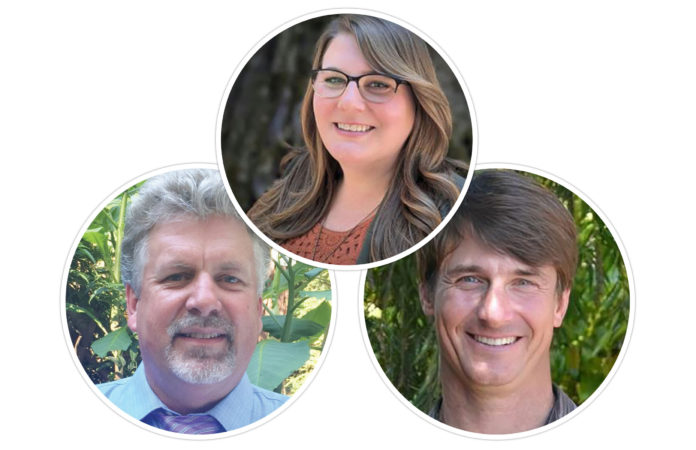
With the November election just weeks away, residents are facing an onslaught of information regarding candidates and ballot measures. Previously, the Press Banner focused on the two county supervisor candidates for District 5, Christopher Bradford and Monica Martinez. This week we take a dive into the race for San Lorenzo Valley Water District’s Board of Directors.
Current board members include Bob Fultz, Jeff Hill, Bryan Largay, Alina Layng and Mark Smolley. Of the five, Largay and Layng were appointed this year, and their terms end on Nov. 5, making them each incumbents that are running to retain their seats. There are two candidates who have joined the race in an effort to replace Largay and Layng—Bruce Holloway and Bill Smallman.
An Oct. 9 forum, hosted by the Valley Women’s Club and moderated by the Santa Cruz County League of Women Voters at Highlands Park Senior and Community Center in Ben Lomond, was an opportunity for voters to hear from the candidates and learn more about Measure U, a proposal to limit the water district’s billing increases until 2049.
The question posed by Measure U is whether or not the populace will vote to approve or deny repealing all fixed water charges adopted under District Resolution No. 2024—except the regular Service Charge and the Private Fire Service Charge—and limiting future increases to the regular Water Service Charge to 2% per calendar year until Jan. 1, 2049.
First, the candidates. Holloway, Largay, Layng and Smallman were in attendance and after delivering their opening statements, each was asked the same set of questions (submitted by community members) and given 90 seconds to respond. For this event, the personality of each candidate was on display along with their experience and opinions on certain issues.
Some of the questions posed and the candidates’ abbreviated answers follow.
Rainfall management
On the question of the district adapting to changing rainfall dynamics (shorter periods of heavy rainfall and longer drought events), Smallman suggested storing water to help recharge the groundwater basin, and said that his previous years of experience on water boards would make the process “easy.”
Largay said there is a plethora of water sources available in the area (surface water like Fall Creek and groundwater like the Santa Margarita Basin) and alluded to managing those surface water sources during heavy rainfall years, especially when the groundwater basin is over-drafted.
Layng suggested a more creative approach to managing the issue, including more robust rainwater capture options, and prioritizing strengthening the district’s infrastructure.
Holloway referred to the Loch Lomond Reservoir, stating that the district has water rights to 1/8 of its capacity, and suggested that the district devise a three-way agreement between Scotts Valley, Santa Cruz and SLVWD to allow the district to make money off the use of water by the other agencies.
District partnerships
When it comes to SLVWD collaborating with Big Basin Water and Scotts Valley Water District, Largay noted that the Big Basin Water (BBW) utility was burned during the CZU August Lightning Complex Fire in August 2020, and said SLVWD needed to work collaboratively with BBW to help them escape the current crisis their customers are in while ensuring that current SLVWD customers don’t get saddled with those additional costs.
Layng said that her position on this topic has been misrepresented, and she believes that no matter where the water comes from, the communities deserve safe, clean and potable water. She said there is no merger proposal on the table and that the Bracken Brae (BB) and Forest Springs (FS) neighborhoods are in dire need of assistance and are running out of water.
Holloway said the partnership he envisions with Scotts Valley Water District is with the City of Santa Cruz, and that he believes that the three local private water providers (BBW, BB and FS) will eventually merge with SLVWD.
Smallman was involved with the previous Lompico merger with SLVWD, and referred to Largay and Layng as “new school environmentalists” who didn’t have the scope of knowledge that he possesses. He stated that regulations were killing any positive actions within the district and that the conjunctive use plan is “a stupid idea.” (“Conjunctive” water use refers to the coordinated use of surface water and groundwater supplies to efficiently manage water consumption and natural storage through wet- and dry-climatic conditions.)
Affordable water
On the topic of making water more affordable for customers, Layng said that the current rate structure better supports low water usage households based on the tiered rates. She noted that customers who qualify for PG&E’s CARE or FERA programs will automatically qualify for SLVWD’s rate assistance support which offers $20 off one’s monthly bill.
Holloway spoke after Layng and said he disagreed with her position, stating that the current rate plan costs low water users the most, the tiers are upside down and that those users pay more for fixed charges. Although water rates were lowered in the last restructuring, the fixed costs are still exorbitant and Holloway said Measure U is meant to address that inequity.
Smallman answered the question by referencing water mains that are housed above ground and are subject to vandalism, castigating Largay and Layng for their stance on environmental issues and announcing that there are other ways to address rate structures.
For Largay, he said that in order for water to be affordable, SLVWD needs to invest in its infrastructure, noting that the most expensive part of running a water system is response to emergencies like the CZU Fire. Investing in the infrastructure, he said, would allow for “stable, steady prices.”
Climate change
Finally, on the question of how climate change is impacting the district, Layng said that droughts cause the district to rely on groundwater, leaving the potential to overdraft the system and causing it to collapse into itself. Pulling water opens the possibility of drawing contaminants into the system while capturing stream water can be ecologically damaging to local aquatic species.
For Holloway, he explained that the district needs to expand its conjunctive use agreements, specifically allowing Felton’s water to be used in Scotts Valley (SLVWD provides water to some Scotts Valley residents).
Smallman announced that he is a “self-educated scientist” and that there is no published theory on it. He said that NASA’s Dr. James Hansen, who testified to the U.S. Senate in June 1988 stating the greenhouse effect had been detected, thereby indicating that the climate was in fact changing, is a “quack.” He reverted to his argument that building more reservoirs is the answer to the issue, and ended his answer with, “Climate change is a hoax.”
Largay said that climate change in our area “is making things more expensive and less predictable.” He tied in the increased costs of fire insurance and the deleterious effects of landslides, road closures and slip outs, saying that due to the heavy burden being placed on communities as a result of climate change, “we need to stick together” by investing in our infrastructure and water district.
The 90-minute candidate forum wrapped up, and after 10 minutes, the Measure U forum began. Read about that here next week.













This district deserves more then .self educated scientists Mr Smallman.